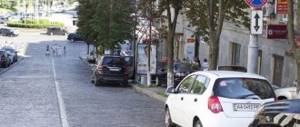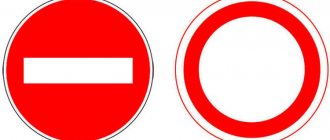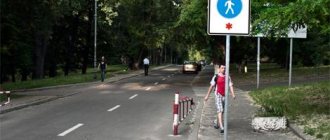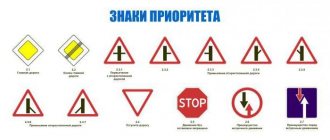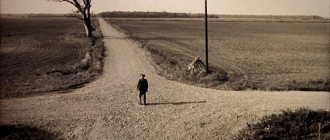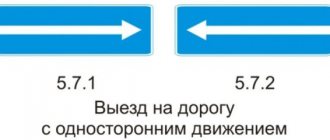The Give Way sign is one of the most commonly seen road signs. It is usually used at the intersections of two roads or when exiting a secondary road onto a highway. The purpose of this road sign is to prevent accidents in cases where two or more traffic flows intersect.
- 2 Why and where to install
- 3 Coverage
- 4 traffic rules
- 5 Fines for violations
What does road sign 2.4 mean? Definition
Sign 2.4 “Give way” is, according to the Russian traffic rules, a priority sign, meaning the need to give way to vehicles moving along the road being crossed. At the same time, it is separately stated that if there is a sign 8.13, it is necessary to let those moving along the main road pass.
The situation with plate 8.13 requires special attention. We will return to it later when we talk about who should let whom through, but for now we focus on the fact itself: without a sign we let everyone through, with a sign - those who are on the main road .
8(800)350-23-68
Dmitry Konstantinovich
Expert of the site "Legal Consultant"
Ask a Question
Sometimes you can find information about a certain “relatedness” of sign 2.4 with sign 2.5 “Moving without stopping is prohibited.” They say that the first is supposedly a “light version” of the second. Perhaps some common features can be found, but in our opinion, and this is especially true for inexperienced drivers, attempting such a comparison is filling one’s head with unnecessary information. There are signs, there are their requirements - the requirements need to be known and fulfilled. The rest is extra and unnecessary information.
Another formal point. The official name of the sign, according to current laws, has the more respectful form “Give way ,” but often, out of habit, it is simply called “Ledge and road,” and sometimes they even remember the form “Do not interfere” that has been inactive for many years.
Whichever of these phrases appears later in the text, one must understand that we are talking about the same sign 2.4.
When entering an intersection you:
| 1. | Must give way only to motorcycles. |
| 2. | Must give way to both vehicles. |
| 3. | You have the right of way. |
When entering an intersection where there is a roundabout, marked with sign 4.3 “Roundabout,” you are required to give way to all vehicles moving at such an intersection (Traffic Regulations 13.11.1).
What does a Give Way sign look like?
There are not many signs in the Russian Traffic Regulations that have a unique shape. “Give way” is one of them. This is the only sign that has a triangular shape, but is located with the apex down. The sign has a red border (possibly in a white thin frame) and a white background.
According to the provisions of the current GOST R 52290-2004, the sign looks like this:
Road sign 2.4 - Give way
As for similar signs in other countries, they may differ slightly (usually in the presence of an inscription), but they all have the same shape of an inverted triangle.
| France | |
| USA | |
| Australia | |
| Great Britain | |
| India |
What signs require a mandatory stop?
| 1. | Only A and B. |
| 2. | Only B. |
| 3. | Only B and C. |
| 4. | All. |
Answer
| Only the STOP sign B obliges drivers to stop at the stop lines, and if there are no stop lines, before the edge of the roadway being crossed; at the railway crossing, in front of the sign. |
| Sign B “Stop line” shows only the place where vehicles stop when there is a prohibiting signal from a traffic light or a traffic controller. |
| Sign G “Give way” obliges the driver to give way, if necessary, at a road intersection. |
| Sign A “Give way to oncoming traffic” obliges the driver to give way, if necessary, on a narrow section of the road. |
Why and where is it installed?
According to Russian traffic rules, the “Give way” sign indicates the need to give way to vehicles moving along the roadway being crossed. From this follows an unambiguous parameter for its installation - before the intersection .
At the same time, there are signs that may accompany sign 2.4, significantly influencing the standards for its use. Let us emphasize that we are talking specifically about additional elements, i.e. when using “Give Way” without them, there is no alternative - you must let all traffic participants on the intersecting roads pass. At the same time, if additional instructions are available, the situation may change.
Plate 8.13 - Main Road Direction
We are talking about the very sign that is mentioned in the definition of sign 2.4, according to which it is necessary to let all those who are located on the main road pass.
8(800)350-23-68
Dmitry Konstantinovich
Expert of the site "Legal Consultant"
Ask a Question
Many people mistakenly believe that such a rule means that there is no need to allow traffic moving along the secondary route to pass. This is wrong . The priority of movement along equivalent secondary ones is determined by other rules, and primarily by interference on the right. In the above example (picture above), you are required to let a bus and a car pass on the right, as they are on the main road, and should not let a motorcycle pass. However, if you look at the situation through the eyes of a motorcyclist, in front of whom there is a similar sign, then he should let everyone through, including you, despite being in the secondary lane, because your car will be an obstacle to him on the right.
Table 8.1.1 - Distance to object
We are talking about a standard sign indicating the distance to sign 2.4. The main thing to understand here is that the sign itself, the requirement of which must be fulfilled, is located directly in front of the intersection and does not have a sign 8.1.1, and “Give way” with such a sign only informs about the upcoming intersection. There is no need to comply with the requirement of sign 2.4 with plate 8.1.1.
Table 8.1.2 - Distance to object - Stop
Despite the identity of the names, we are talking about a completely different case. This sign can only exist together with the “Give Way” sign and, according to the Russian Traffic Regulations, it means that within the specified distance there is - attention! – sign 2.5 “Passing without stopping is prohibited.” In other words, there is an intersection ahead, stopping before which is mandatory .
Accordingly, here we can say that sign 2.4 with plate 8.1.2 is informational and does not require performing any actions at its location.
Effective area of sign 2.4 “Give way”
The “Give Way” sign, which directly indicates the need to let other traffic pass, does not have a sign or conditions that cancel its effect (with the exception of conflicting signals from a traffic light or a traffic controller, which we will discuss separately). Consequently, sign 2.4 is valid only within the boundaries of the intersection in front of which it is installed - the term coverage area is irrelevant for it.
You intend to turn right. Can you start turning?
| 1. | Yes. |
| 2. | Yes, but without interfering with the truck. |
| 3. | No. |
The “Give Way” sign obliges you to give way to a truck at a given intersection of unequal roads, without requiring you to stop before the intersection. Since the truck is moving in the left lane, which is further away from you, you can proceed to turn right. However, during the entire maneuver you must not interfere with the movement of the truck.
Rules for leaving a secondary road
We have already touched on the main rules in one way or another, more than once. However, there are also certain conditions associated with associated factors. Let's remember the main thing:
- Sign 2.4 without plates . The rule is as simple as possible - you need to let through everyone for whom you can create an obstacle to the movement (does not apply to those moving in the same direction as you).
- Sign 2.4 with plate 8.13 . In this case, vehicles on the main road are allowed to pass; passing vehicles on the secondary road must be passed in accordance with other traffic rules.
And then we will consider situations created by additional conditions.
Priorities: traffic controller, traffic light, sign, markings
The situation here is quite standard. The list of priorities common to all cases (if different indicators contradict each other) also works in this case:
- If there is a traffic controller, everyone fulfills his requirements, ignoring contradictory ones. If there is no traffic controller, then:
- Traffic light signals have priority. If there is no traffic light or it does not work / blinks yellow, then:
- The requirements of road signs (primarily temporary ones, if any), including 2.4, are met; if there are no signs or they are not visible, then:
- The markup requirement is met.
What to do if there is nothing or nothing is visible? Let's remember clause 13.13 of the Russian Traffic Regulations - if it is impossible to determine the surface and there are no priority signs, you should assume that you are on a secondary road .
8(800)350-23-68
Dmitry Konstantinovich
Expert of the site "Legal Consultant"
Ask a Question
Do not forget about clause 3.2 of the traffic rules, which establishes the undeniable advantage of vehicles with flashing lights, and also that you must always yield to a pedestrian. There are also rules when giving preference to the tram.
At a roundabout
Until recently, driving through a roundabout was carried out according to the “right hand” rules, but with the presence of sign 2.4, priorities could change. However, according to the current standards, sign 4.3 “Roundabout” indicates a roundabout, traffic along which is regulated by clause 13.11(1) of the Russian Federation Traffic Regulations (sometimes referred to as clause 13.11.1), according to which those who is already at the crossroads .
Accordingly, a separate installation of sign 2.4 before the roundabout is no longer necessary. Sign 4.3, by default, requires giving way to all traffic participants at the intersection.
Where do you need to stop before sign 2.4 “Give way”?
To determine the stopping place, you must follow the following rule:
If there are no markings, you must stop before the road begins to cross traffic. There are no exact parameters here, the main thing is not to drive onto the road being crossed if other vehicles are moving along it.
The intersection may have markings 1.13, which is sometimes mistakenly called “Give Way.” This marking is indeed often adjacent to sign 2.4, and in this case it requires stopping before its line . However, in fact, the markings are not tied only to the “Give Way” sign, and can be used without it. This is important when resolving some controversial issues, which we will discuss below.
In addition to marking 1.13, marking 1.20 can also be used before it - a warning about approaching marking 1.13. It looks like this:
Can sign 2.4 be used with a stop line or sign 6.16?
Unlike the marking 1.13 indicated above, which is not tied by the rules to any sign or circumstance (although in practice it is most often adjacent to “Give way”), the stop line (marking 1.12) according to the traffic rules indicates the place of stopping at the STOP sign or a traffic light, and sign 6.16 (stop line) - for a traffic light or traffic controller.
Accordingly, “Give way” may be adjacent to stop lines at an intersection (marking 1.12 and/or sign 6.16), but only if there is a traffic controller, a traffic light and/or sign 2.5 “Passing without stopping is prohibited.”
8(800)350-23-68
Dmitry Konstantinovich
Expert of the site "Legal Consultant"
Ask a Question
Sometimes difficulties arise in determining the rules of passage if markings 1.13 are present, but there are no signs, including 2.4. Should we assume that the marking establishes requirements similar to sign 2.4? It is no coincidence that we pointed out above that the name of this marking is erroneous in some sources, which call it “Give way.” There is no such name in the Russian Federation Traffic Regulations, but there is an indication of the place of the necessary stop to let vehicles moving along the crossing road pass. Accordingly, marking 1.13 is not a replacement for sign 2.4, and traffic at such an intersection will be regulated by other traffic rules.
What to do if oncoming traffic is difficult?
If this problem arises, the motorist should be guided by rule 11.7 - if oncoming traffic is difficult for traffic on the side of the obstacle, then the free (preferential) side must give way.
Also, the motorist must give way if there are signs:
- 1.13 slope of the road surface when lifting;
- 1.14 slope of the road surface during descent.
Sign 1.13 - “Steep Descent”
The one on whose side there is a sign gives way. If the obstacle is a slope, then such paths are indicated by signs 1.13 (steep descent) and 1.14 (steep climb); in this case, the driver who goes down the mountain gives way.
Fines for traffic violations
The most widely applicable norm in such cases is Part 2 of Article 12.13 of the Code of Administrative Offenses of the Russian Federation - a fine of 1000 rubles for refusing to give way to vehicles that have the right of way. However, at the same time, other rules may be violated, and then penalties imply other types of punishments.
It is worth noting that information is often found that the rule about “dangerous driving” may also apply here. Even Article 12.38 of the Code of Administrative Offenses of the Russian Federation is indicated, according to which a fine will supposedly be imposed. Indeed, the traffic rules have introduced a provision prohibiting dangerous driving, the definition of which could theoretically include the violation in question. However, there is no article 12.38 in the Administrative Code yet . It is only in the bill, which at the time of publication of this material has not yet been adopted.
Can you start overtaking?
| 1. | Yes, if overtaking is completed before the intersection. |
| 2. | Yes. |
| 3. | No. |
You are approaching an uncontrolled intersection on a minor road (Give Way sign). At uncontrolled intersections, overtaking is prohibited when driving on a road that is not the main one. Therefore, in this situation, overtaking a truck can only begin if it is completed before the intersection.
Installation location
As a rule, it is located just before the intersection of roads, however, it can also be used as a backup, that is, it can be installed additionally at a certain distance from the main one. Also, the sign can be located at a distance from the intersection, namely 150-300 meters outside populated areas. At the same time, there is a sign with it: “Distance to object.”
It should be noted that this sign is often located in front of a railway crossing, but loses its effect if there is a traffic light at such a crossing. The sign is usually installed at the exit from dirt roads onto the asphalt part, onto the highway (high-speed lane), as well as at exit points from adjacent territories.
It cannot be ignored under any circumstances, since it is mainly located in front of an intersection where there is poor visibility and, accordingly, an increased risk of an accident.
Signs of special regulations
This group is intended for entering or canceling a special auto mode. They are made in the form of a rectangular shape, predominantly blue, in some cases the background is green.
Signs warn of the following traffic conditions:
- the presence of an expressway and its end;
- availability of roads only for cars, buses, motorcycles;
- one-way highways and exits;
- reverse movement and entering the road with such a move;
- the existence of a highway with a lane for shuttle buses, cyclists and the ability to access it;
- the lane for minibuses or cyclists and its end;
- direction of movement along the lanes and the beginning/end of such a section of the road;
- number of lanes;
- the place where a regular vehicle stops;
- the presence of a pedestrian crossing, an artificial unevenness, a residential area, a populated area, an area with limited parking, including a regulated one, a pedestrian or bicycle section, an area with an eco-class restriction for motor transport.
External signs
The triangle shape is used in warning and priority signs. Framed with a red border, it focuses the driver’s attention on a specific action that he must adhere to. The sign also warns the driver that ahead there is an intersection of the main road with a secondary one or the junction of the latter.
It is an inverted triangle shape on a white background, with a red line around the edges. It was designed in this way so that the sign was not similar to all the others and was recognizable by the driver even in poor visibility conditions. Also, for example, the symbol with the inscription STOP in the form of an octagon has a unique shape. These signs have a special meaning and should therefore be recognized by road users as best as possible.
Oddly enough, the appearance of the sign has not changed since the beginning of the 20th century, when these symbols just began to be introduced to regulate traffic. But then it had a different name: “Do not interfere.”
There are situations when the sign becomes unreadable, for example, it may be covered with snow or stained with mud. Accordingly, if the sign were similar in shape and color to the others, it would become unrecognizable. In addition, there is one important plus - it is also easily distinguishable from the oncoming lane. For comparison, on foreign roads this symbol is the same, only the Give Way inscription is added to it.
Expensive and angry
In Europe, it is customary to be a polite driver. Being impolite is at least expensive. German traffic regulations, for example, stipulate unacceptable behavior on the road. Fines are imposed for showing the middle finger, insults and sticking out your tongue.
The minimum penalty for intemperance is €200. For indecent gestures, the fine can increase to 3-4 thousand. The German “idiot test” is of particular interest. Drivers who have violated the rules more than twice are referred to it. Motorists dread this test because it is almost impossible to pass without preparation. You need to attend about 40 classes with a psychologist who, with German meticulousness, will tell you how to drive a car correctly and behave behind the wheel. One lesson will cost €100. This is in addition to the fine for violation.
In the USA, each state may have its own traffic rules, sometimes quite strange. In Nevada, it is illegal to ride a camel on the expressway; violating it can result in prison. In Pennsylvania, the driver must have a car cover so that when he encounters a wagon, he can cover the car without spooking the horse. You are also not allowed to honk near eateries after nine in the evening. In Massachusetts, it is illegal for anyone except truck drivers to spit out of a window. In California, you will be punished for resting on the asphalt. There, a woman cannot drive in a dressing gown. In Idaho, people over 88 are prohibited from driving a motorcycle.
In Japan, people drive with extreme caution after rain. If you spray a pedestrian, you'll get a fine of about €40
You intend to turn right. Can you start turning?
| 1. | Yes. |
| 2. | Yes, after the truck starts turning. |
| 3. | No. |
A “Give Way” sign requires you to yield the right of way to a truck approaching an unequal intersection on the road being crossed. Since Yield does not require you to stop, you can begin turning right once you are sure the truck is actually turning left. At the same time, during the entire maneuver you should not interfere with its movement.

